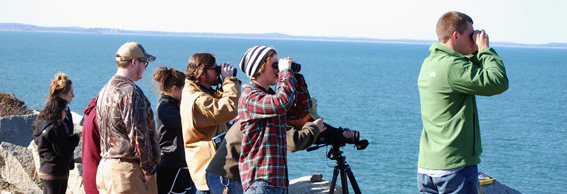Gordon in the News: last updated 11/17/2012
By Cyndi McMahon

Cape Ann, a peninsula that juts out into the Gulf of Maine just north of Boston, provides more coves, beaches, tidal pools and offshore escapes than most of the New England coastline. For Gordon students, coastal living is a year-round paradise. But if your vocation includes a love for science, the shoreline also becomes very personal.
Any student taking courses with Gregory Keller, associate professor of conservation biology, will talk about the spectrum of research and science activities their professor provides both in the lab and in the local environment. But sometimes it's good to put down the notebook, stop collecting data and look around for the sheer pleasure of observation.
Bird Walkers and Watchers
Saturday, November 10, 17 students in the Biology Club spent the afternoon observing the avian world along the coastline of Gloucester; the small seaport town of Rockport; and at Halibut Point State Park. "Giving up a Saturday during the peak of the semester, with grading and personal projects, is always a challenge, especially with winter looming and a pile of unstacked wood in my driveway," says Keller. "But when someone asks for a bird walk, the naturalist in me can’t help but say yes. I enjoy taking as many first-timers as possible out birdwatching, to show the glory and wonder that is this world."
He adds, "To have 17 students wake up early on a weekend wanting to experience something outside of their typical lives illustrates why my decision to teach at Gordon continues to be a good one." Stocked with warm clothing, binoculars, a resource guide and Gordon's most inspirational bird lover, the group headed to the banks of Cape Ann.
Panoramic Views
One of their viewpoints was the Great Atlantic Path, which traverses three miles of weather-beaten bluffs and ends at Halibut Point State Park. Also visible at the Park are a granite quarry (made of 440-million-year-old granite sheets that once supplied the stone for Boston's Custom House); a natural spring; and a tower that guarded Boston and Portsmouth harbors during World War II. This seaside park provides a panoramic view that includes Crane Beach in Ipswich, Mount Agamenticus in Maine, and the Isles of Shoals off the coast of New Hampshire. Its beauty is hard to beat and the bird watching is ideal this time of year.
More than 400 species of birds live in this area of Essex County. Winds from the east increase the birdwatching possibilities, as birds feast on harbor snails, hermit crabs and sea stars in the shallow cold waters. "Halibut Point again proved to be my favorite for local bird watching," says Keller, "especially when a Red-tailed Hawk sped past our view to perch and appraise us from an oak tree."
Ean Mullins '15, a biology and chemistry double major from Duluth, Minnesota, was one of the students who went on the excursion. "The first birds we saw were a couple of crows and a European Starling," said Mullins. "Dr. Keller said we couldn't count them because they weren't cool enough, so our first 'official' bird that day was spotting a mockingbird." His favorite part of the experience was seeing a flock of eight Harlequin Ducks and "talking with Dr. Keller (using his code name 'Papa Smurf') over walkie-talkies between [their] two vehicles" as they drove along the coast. Mullins admits Gordon's coastal location was a significant factor when he was looking to study science at a Christian college, as was Gordon's reputation for invested teachers. "My friends from other schools rarely believe me when I talk about the access that I have to my professors. None of them would believe I am close enough to Dr. Keller to have a code name chat over walkie-talkies. I absolutely love that about this place. The willingness to invest in students off-hours and joke around getting to know us—it's just so cool to me."
Discoveries
 Keller's favorite moment of the trip was spotting the Harlequin Duck—a masterpiece
Keller's favorite moment of the trip was spotting the Harlequin Duck—a masterpiece
of slate gray, rust, and white in a remarkable pattern. "It is a relatively uncommon bird of
the coast and one whose return I always anxiously await each winter," he says. ”We were treated to close views of two flocks, as
they bobbed unmistakably in the tumultuous surf – a wonderful part of our trip."
The team recorded 22 species of birds before heading back to campus. "This Biology Club trip was a highlight of the Fall 2012 semester for me," says Keller. "I can’t help but consider the students who were with me—17 busy students with a free morning in the heart of a critical semester as they try to maintain high GPAs, apply for internships, make decisions about jobs, graduate schools, or medical schools, and evaluate their futures. This is what they chose to do on a free morning—hang around with their aging professor outside of class, laughing, hiking, and watching sea ducks and mockingbirds??!! These days remind me why I am here."
###
Greg Keller joined the Gordon College faculty in 2007 after teaching for five years at Eastern New Mexico University, where he was an assistant professor of wildlife ecology. As a conservation biologist, Dr. Keller focuses his research on the impact humans have on biological systems, including a variety of taxonomic groups (birds, mammals, amphibians and insects) and biological scales (habitats, landscapes and ecosystems).
Story by Cyndi McMahon, Director of Marketing Communications at Gordon College. [email protected]; @Gordon_CMcMahon